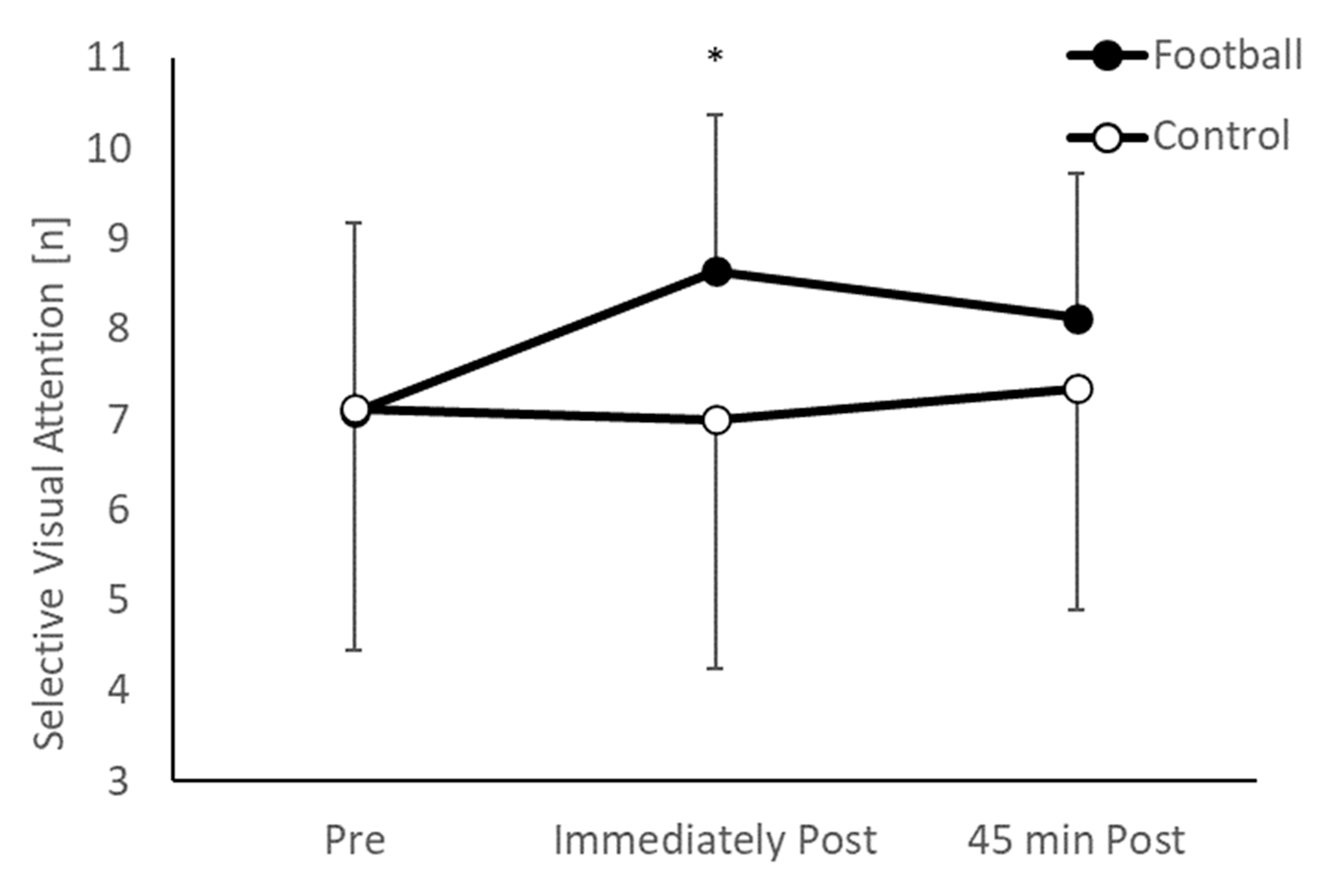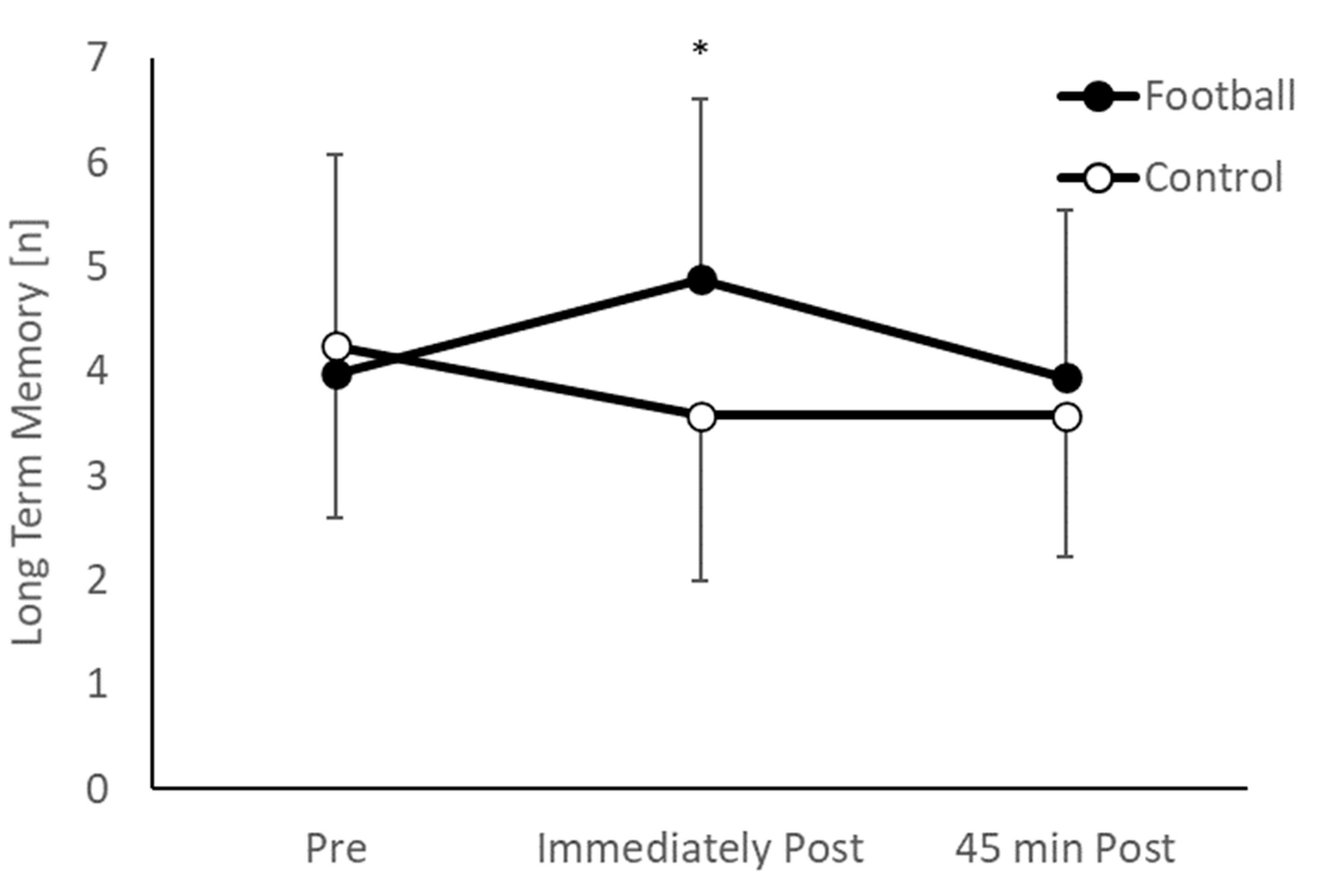An After-School Football Session Transiently Improves Cognitive Function in Children
Abstract
1. Introduction
2. Materials and Methods
2.1. Study Design
2.2. Participants
2.3. Experimental Protocol
2.4. Football Session
2.5. Cognitive Function Tests
2.6. Statistical Analysis
3. Results
3.1. Selective Visual Attention
3.2. Short Term Memory
3.3. Long Term Memory
4. Discussion
5. Conclusions
Author Contributions
Funding
Institutional Review Board Statement
Informed Consent Statement
Data Availability Statement
Acknowledgments
Conflicts of Interest
References
- Schmitt, J.A.; Benton, D.; Kallus, K.W. General Methodological Considerations for the Assessment of Nutritional Influences on Human Cognitive Functions. Eur. J. Nutr. 2005, 44, 459–464. [Google Scholar] [CrossRef] [PubMed]
- Best, J.R.; Miller, P.H.; Naglieri, J.A. Relations between Executive Function and Academic Achievement from Ages 5 to 17 in a Large, Representative National Sample. Learn. Individ. Differ. 2011, 21, 327–336. [Google Scholar] [CrossRef] [PubMed]
- Magistro, D.; Bardaglio, G.; Rabaglietti, E. Gross Motor Skills and Academic Achievement in Typically Developing Children: The Mediating Effect of Adhd Related Behaviours. Cogn. Creier Comport. /Cogn. Brain Behav. 2015, 19, 149–163. [Google Scholar]
- Magistro, D.; Cooper, S.B.; Carlevaro, F.; Marchetti, I.; Magno, F.; Bardaglio, G.; Musella, G. Two Years of Physically Active Mathematics Lessons Enhance Cognitive Function and Gross Motor Skills in Primary School Children. Psychol. Sport Exerc. 2022, 63, 102254. [Google Scholar] [CrossRef]
- Magistro, D.; Piumatti, G.; Carlevaro, F.; Sherar, L.B.; Esliger, D.W.; Bardaglio, G.; Magno, F.; Zecca, M.; Musella, G. Psychometric Proprieties of the Test of Gross Motor Development–Third Edition in a Large Sample of Italian Children. J. Sci. Med. Sport 2020, 23, 860–865. [Google Scholar] [CrossRef]
- Boat, R.; Cooper, S.B.; Carlevaro, F.; Magno, F.; Bardaglio, G.; Musella, G.; Magistro, D. 16 Weeks of Physically Active Mathematics and English Language Lessons Improves Cognitive Function and Gross Motor Skills in Children Aged 8–9 Years. Int. J. Environ. Res. Public Health 2022, 19, 16751. [Google Scholar] [CrossRef]
- Cooper, S.B.; Bandelow, S.; Nevill, M.E. Breakfast Consumption and Cognitive Function in Adolescent Schoolchildren. Physiol. Behav. 2011, 103, 431–439. [Google Scholar] [CrossRef]
- Mahoney, C.R.; Taylor, H.A.; Kanarek, R.B.; Samuel, P. Effect of Breakfast Composition on Cognitive Processes in Elementary School Children. Physiol. Behav. 2005, 85, 635–645. [Google Scholar] [CrossRef]
- Hillman, C.H.; Pontifex, M.B.; Raine, L.B.; Castelli, D.M.; Hall, E.E.; Kramer, A. The Effect of Acute Treadmill Walking on Cognitive Control and Academic Achievement in Preadolescent Children. Neurosci. 2009, 159, 1044–1054. [Google Scholar] [CrossRef]
- Hatch, L.M.; Williams, R.A.; Dring, K.J.; Sunderland, C.; Nevill, M.E.; Sarkar, M.; Morris, J.G.; Cooper, S.B. The Daily MileTM: Acute Effects on Children’s Cognitive Function and Factors Affecting Their Enjoyment. Psychol. Sport Exerc. 2021, 57, 102047. [Google Scholar] [CrossRef]
- Griffiths, L.J.; Cortina-Borja, M.; Sera, F.; Pouliou, T.; Geraci, M.; Rich, C.; Cole, T.J.; Law, C.; Joshi, H.; Ness, A.R. How Active Are Our Children? Findings from the Millennium Cohort Study. BMJ Open 2013, 3, e002893. [Google Scholar] [CrossRef]
- Janssen, I.; LeBlanc, A.G. Systematic Review of the Health Benefits of Physical Activity and Fitness in School-Aged Children and Youth. Int. J. Behav. Nutr. Phys. Act. 2010, 7, 40. [Google Scholar] [CrossRef] [PubMed]
- Biddle, S.J.; Asare, M. Physical Activity and Mental Health in Children and Adolescents: A Review of Reviews. Br. J. Sport. Med. 2011, 45, 886–895. [Google Scholar] [CrossRef] [PubMed]
- Bailey, R.C.; Olson, J.; Pepper, S.L.; Porszasz, J.; Barstow, T.J.; Cooper, D.M. The Level and Tempo of Children’s Physical Activities: An Observational Study. Med. Sci. Sport. Exerc. 1995, 27, 1033–1041. [Google Scholar] [CrossRef] [PubMed]
- Hatch, L.M.; Williams, R.A.; Dring, K.J.; Sunderland, C.; Nevill, M.E.; Cooper, S.B. Activity Patterns of Primary School Children during Participation in The Daily Mile. Sci. Rep. 2021, 11, 7462. [Google Scholar] [CrossRef] [PubMed]
- Svensson, M.; Drust, B. Testing Soccer Players. J. Sport. Sci. 2005, 23, 601–618. [Google Scholar] [CrossRef]
- Howe, C.A.; Freedson, P.S.; Feldman, H.A.; Osganian, S.K. Energy Expenditure and Enjoyment of Common Children’s Games in a Simulated Free-Play Environment. J. Pediatr. 2010, 157, 936–942. [Google Scholar] [CrossRef]
- Donnelly, J.E.; Hillman, C.H.; Castelli, D.; Etnier, J.L.; Lee, S.; Tomporowski, P.; Lambourne, K.; Szabo-Reed, A.N. Physical Activity, Fitness, Cognitive Function, and Academic Achievement in Children: A Systematic Review. Med. Sci. Sport. Exerc. 2016, 48, 1197. [Google Scholar] [CrossRef]
- Williams, R.A.; Hatch, L.; Cooper, S.B. A Review of Factors Affecting the Acute Exercise-Cognition Relationship in Children and Adolescents. OBM Integr. Complement. Med. 2019, 4, 049. [Google Scholar] [CrossRef]
- Li, J.W.; O’Connor, H.; O’Dwyer, N.; Orr, R. The Effect of Acute and Chronic Exercise on Cognitive Function and Academic Performance in Adolescents: A Systematic Review. J. Sci. Med. Sport 2017, 20, 841–848. [Google Scholar] [CrossRef]
- Cooper, S.B.; Dring, K.J.; Morris, J.G.; Sunderland, C.; Bandelow, S.; Nevill, M.E. High Intensity Intermittent Games-Based Activity and Adolescents’ Cognition: Moderating Effect of Physical Fitness. BMC Public Health 2018, 18, 603. [Google Scholar] [CrossRef]
- Lind, R.R.; Beck, M.M.; Wikman, J.; Malarski, K.; Krustrup, P.; Lundbye-Jensen, J.; Geertsen, S.S. Acute High-Intensity Football Games Can Improve Children’s Inhibitory Control and Neurophysiological Measures of Attention. Scand. J. Med. Sci. Sport. 2019, 29, 1546–1562. [Google Scholar] [CrossRef] [PubMed]
- Williams, R.A.; Cooper, S.B.; Dring, K.J.; Hatch, L.; Morris, J.G.; Sunderland, C.; Nevill, M.E. Effect of Football Activity and Physical Fitness on Information Processing, Inhibitory Control and Working Memory in Adolescents. BMC Public Health 2020, 20, 1398. [Google Scholar] [CrossRef] [PubMed]
- Tanner, J.M. Growth at Adolescence, 2nd ed.; Blackwell Scientific Publications: Oxford, UK, 1962; pp. 1–325. [Google Scholar]
- Malina, R.M.; Eisenmann, J.C.; Cumming, S.P.; Ribeiro, B.; Aroso, J. Maturity-Associated Variation in the Growth and Functional Capacities of Youth Football (Soccer) Players 13–15 Years. Eur. J. Appl. Physiol. 2004, 91, 555–562. [Google Scholar] [CrossRef] [PubMed]
- Lenroot, R.K.; Giedd, J.N. Brain Development in Children and Adolescents: Insights from Anatomical Magnetic Resonance Imaging. Neurosci. Biobehav. Rev. 2006, 30, 718–729. [Google Scholar] [CrossRef]
- Tomporowski, P.D.; Lambourne, K.; Okumura, M.S. Physical Activity Interventions and Children’s Mental Function: An Introduction and Overview. Prev. Med. 2011, 52, S3–S9. [Google Scholar] [CrossRef]
- Pruna, R.; Bahdur, K. Cognition in Football. J. Nov. Physiother. 2016, 6, 316. [Google Scholar] [CrossRef]
- Faul, F.; Erdfelder, E.; Lang, A.-G.; Buchner, A. G* Power 3: A Flexible Statistical Power Analysis Program for the Social, Behavioral, and Biomedical Sciences. Behav. Res. Methods 2007, 39, 175–191. [Google Scholar] [CrossRef]
- Bisiacchi, P.S.; Cendron, M.; Gugliotta, M.; Tressoldi, P.E.; Vio, C. BVN 5-11: Batteria Di Valutazione Neuropsicologica per l’età Evolutiva; Centro studi Erickson Trento: Trento, Italy, 2005; pp. 1–310. [Google Scholar]
- Moore, T.; Zirnsak, M. Neural Mechanisms of Selective Visual Attention. Annu. Rev. Psychol. 2017, 68, 47–72. [Google Scholar] [CrossRef]
- Nitch, S.; Boone, K.B.; Wen, J.; Arnold, G.; Alfano, K. The Utility of the Rey Word Recognition Test in the Detection of Suspect Effort. Clin. Neuropsychol. 2006, 20, 873–887. [Google Scholar] [CrossRef]
- Diamond, A.; Lee, K. Interventions Shown to Aid Executive Function Development in Children 4 to 12 Years Old. Science 2011, 333, 959–964. [Google Scholar] [CrossRef]
- Alesi, M.; Bianco, A.; Padulo, J.; Luppina, G.; Petrucci, M.; Paoli, A.; Palma, A.; Pepi, A. Motor and Cognitive Growth Following a Football Training Program. Front. Psychol. 2015, 6, 1627. [Google Scholar] [CrossRef] [PubMed]
- Alesi, M.; Bianco, A.; Padulo, J.; Vella, F.P.; Petrucci, M.; Paoli, A.; Palma, A.; Pepi, A. Motor and Cognitive Development: The Role of Karate. Muscles Ligaments Tendons J. 2014, 4, 114. [Google Scholar] [CrossRef] [PubMed]
- Starkes, J.L. Skill in Field Hockey: The Nature of the Cognitive Advantage. J. Sport Psychol. 1987, 9, 146–160. [Google Scholar] [CrossRef]
- Morris-Binelli, K.; van Rens, F.E.; Müller, S.; Rosalie, S.M. Psycho-Perceptual-Motor Skills Are Deemed Critical to Save the Penalty Corner in International Field Hockey. Psychol. Sport Exerc. 2020, 51, 101753. [Google Scholar] [CrossRef]
- Marasso, D.; Laborde, S.; Bardaglio, G.; Raab, M. A Developmental Perspective on Decision Making in Sports. Int. Rev. Sport Exerc. Psychol. 2014, 7, 251–273. [Google Scholar] [CrossRef]
- Cooper, S.B.; Bandelow, S.; Nute, M.L.; Dring, K.J.; Stannard, R.L.; Morris, J.G.; Nevill, M.E. Sprint-Based Exercise and Cognitive Function in Adolescents. Prev. Med. Rep. 2016, 4, 155–161. [Google Scholar] [CrossRef]



| Test Variable | Intervention Group | Control Group | ||||
|---|---|---|---|---|---|---|
| Pre | Immediately Post | 45 Min Post | Pre | Immediately Post | 45 Min Post | |
| Selective visual attention | 7.08 ± 2.69 | 8.64 ± 2.69 | 8.12 ± 2.68 | 7.12 ± 2.66 | 7.00 ± 2.75 | 7.34 ± 2.45 |
| Short term memory | 5.52 ± 2.09 | 6.44 ± 1.73 | 5.58 ± 1.60 | 5.76 ± 1.94 | 5.44 ± 1.62 | 5.30 ± 1.66 |
| Long term memory | 3.98 ± 1.89 | 4.88 ± 1.70 | 3.94 ± 1.32 | 4.24 ± 1.65 | 3.58 ± 1.59 | 3.58 ± 1.36 |
Disclaimer/Publisher’s Note: The statements, opinions and data contained in all publications are solely those of the individual author(s) and contributor(s) and not of MDPI and/or the editor(s). MDPI and/or the editor(s) disclaim responsibility for any injury to people or property resulting from any ideas, methods, instructions or products referred to in the content. |
© 2022 by the authors. Licensee MDPI, Basel, Switzerland. This article is an open access article distributed under the terms and conditions of the Creative Commons Attribution (CC BY) license (https://creativecommons.org/licenses/by/4.0/).
Share and Cite
Magistro, D.; Cooper, S.B.; Boat, R.; Carlevaro, F.; Magno, F.; Castagno, C.; Simon, M.; Musella, G. An After-School Football Session Transiently Improves Cognitive Function in Children. Int. J. Environ. Res. Public Health 2023, 20, 164. https://doi.org/10.3390/ijerph20010164
Magistro D, Cooper SB, Boat R, Carlevaro F, Magno F, Castagno C, Simon M, Musella G. An After-School Football Session Transiently Improves Cognitive Function in Children. International Journal of Environmental Research and Public Health. 2023; 20(1):164. https://doi.org/10.3390/ijerph20010164
Chicago/Turabian StyleMagistro, Daniele, Simon B. Cooper, Ruth Boat, Fabio Carlevaro, Francesca Magno, Cristian Castagno, Martina Simon, and Giovanni Musella. 2023. "An After-School Football Session Transiently Improves Cognitive Function in Children" International Journal of Environmental Research and Public Health 20, no. 1: 164. https://doi.org/10.3390/ijerph20010164
APA StyleMagistro, D., Cooper, S. B., Boat, R., Carlevaro, F., Magno, F., Castagno, C., Simon, M., & Musella, G. (2023). An After-School Football Session Transiently Improves Cognitive Function in Children. International Journal of Environmental Research and Public Health, 20(1), 164. https://doi.org/10.3390/ijerph20010164








